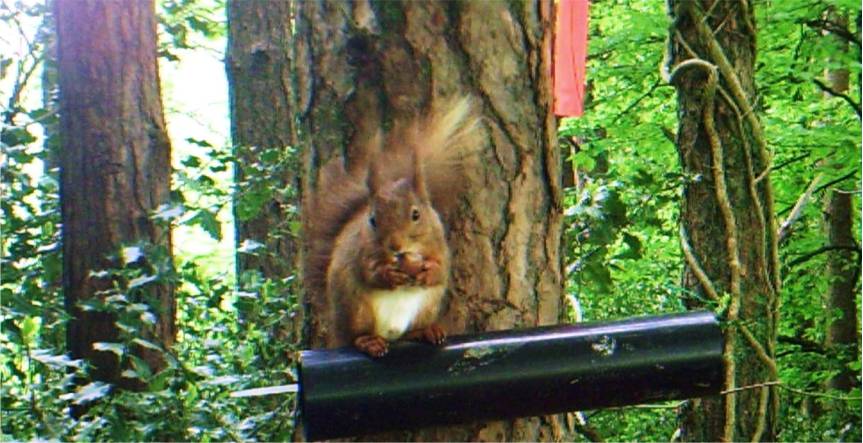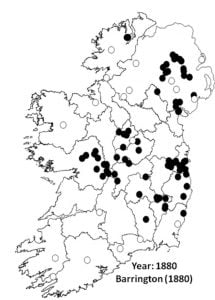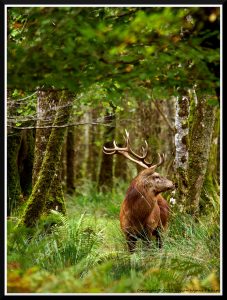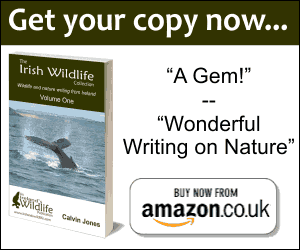
The red squirrel (Sciurus vulgaris) is one of our most charismatic species, found in woodlands in many parts of Ireland and is an animal that warms the hearts of those lucky enough to observe it. In recent years the decline of the red squirrel has been associated with the spread of the introduced North American grey squirrel (Sciurus carolinensis), although recent work by Emma Sheehy from NUIG has shown that the red squirrel is recovering in the midlands, associated with a decline in the grey population. It would be easy to assume (and usually is) that red squirrels have always been present in Ireland, but the truth is we don’t fully understand their distant history very well. What we do know is that squirrels have not been recorded in Irish archaeological cave sites, where other Irish mammals have occurred such as the red deer and the stoat. However, as an arboreal forest species, red squirrels are unlikely to be well represented in cave deposits. In fact, squirrels (of which there are over 250 species) are poorly represented in the fossil record across the world, despite their wide distribution.
Luckily, we are quite fortunate to have an excellent account of the red squirrel in Ireland during the 1800s. Richard Barrington, an important Irish naturalist conducted a distribution study of the red squirrel in Ireland in 1880, a paper titled “On the introduction of the red squirrel into Ireland”. Barrington believed that there were no trustworthy early records of red squirrels in Ireland, and that they were never naturally here. In fact, he disputes some of the historical mentions of red squirrels as erroneous, and quite openly criticises the ‘humbler classes’ for not knowing their pine marten from a stoat. He must have been quite the character! We now know that red squirrels did exist in Ireland prior to their reintroduction in the 1800s as the historical export records showed that thousands of red squirrel skins were annually exported from Ireland in the 16th century. The cessation of these exports coincided with an international depression in the fur trading market. Woodland cover was also depleted over this time due to large scale deforestation which drastically reduced the available habitat for red squirrels. Forest cover in Ireland around the year 1600 was estimated to be anywhere between 3-12%. A combination of these factors probably led to the extinction of the red squirrel in Ireland. If red squirrels did survive this period, they were likely to have been found in remote areas that were too difficult to extract the timber from, and therefore were also likely to go unobserved and undocumented.
Back in 1880 with no access to the wonderful mapping system now available at the National Biodiversity Data Centre http://www.biodiversityireland.ie/, one had to write to one’s friends to establish the presence or absence of a species. Barrington wrote to the big houses in Ireland to establish if the red squirrel was present in their area, and if so when its arrival was first noted, and had any introductions been documented?
What emerged from this was some very interesting information. The first documented introduction of the red squirrel in Ireland refers to dates between 1815 and 1825 in Glenmore Estate, Ashford, Co. Wicklow. Other introductions are referred to in Castle Howard estate in Co. Wicklow, where the Countess of Wicklow, Alice Howard, was said to have introduced the species. The Wicklow introduction had spread into Dublin by 1861, and a separate introduction conducted by Joseph Shackleton also took place in Lucan, Dublin in 1876. Joseph was a relative of the great Antarctic explorer, Ernest Shackleton.
Colonel Bruen was reported to have introduced red squirrels into Co. Carlow. At the time of writing, Barrington also had reports of red squirrels in Abbeyleix and Portarlington, and considered that these may have originated from another introduction. Red squirrels were introduced into Birr Castle Co. Offaly by Lord Rosse around the date of 1864. These red squirrels were said to have originated from Sussex and Yorkshire . Barrington believed that these red squirrels had subsequently spread into Tipperary by the time of writing.
Red squirrels were reported to be quite common in Co. Galway in 1880. This was again attributed to an introduction into Castle Taylor, Garbally, by Lord and Lady Glancarty, who introduced two to four pairs of red squirrels that they obtained from London in 1833. A stable boy was later reported to have introduced the red squirrels from Galway into Roscommon in 1865. Red squirrels were also introduced into Castleforbes, Co. Longford between 1836 and 1837. An introduction into Rathowen, Co. Westmeath was also documented to have taken place, by the Battersby family.
In the North of the country, red squirrels were reported near Ramelton, Co. Donegal. When Barrington investigated this, he found that a George Hill had kept tame red squirrels on his property, and it is likely that some escaped. Red squirrels were introduced from England into Moneyglass in Co. Antrim by the Egan family. This introduction was thought to have been successful as many locations in the surrounding area were reported to have red squirrels when Barrington wrote his paper in 1880. Introductions also took place into Co. Down and Louth in the 1850s.
A record of red squirrels was reported in Gorey Co. Wexford in Barrington’s paper, and it was thought that those red squirrels originated from the Co. Wicklow stock. However, there was no mention of red squirrels in any other area in Wexford at this time. There were no records of red squirrels in the south of the country, with their absence verified in Waterford, Cork, Limerick and Kerry. Squirrels were also reported as absent in Cork by the Earl of Bantry, who gave reference to the Glengarriff area and a Dr. Harvey referred to their absence across the entire county. Despite the availability of suitable woodland habitat in the likes of Killarney, Co. Kerry, red squirrels were reported as absent in Muckross House, Killarney, and also in Kenmare.

Thirty years later, red squirrels were present in every county in Ireland (Figure 2), as seen in Monica Shorten’s 1954 book, Squirrels. It is likely that a combination of natural colonisation and further undocumented human introductions facilitated the rapid spread of the species throughout Ireland. By 1915, Barrington wrote that red squirrels had arrived in Waterford and were so common in Portlaw that they were described as a pest. C.B. Moffat wrote in 1923 about the red squirrels in Co. Wexford and reported that they first arrived in Ballyhylands, near Killoughrum in 1890, and started to be become plentiful over the next number of years. The squirrels were regularly seen by Moffat in forestry plantations, but he never observed them in an old forest in Killoughrum despite seeing over 40 red squirrels together in the conifer plantation a mile away. Moffat believed that the population here were not of native Irish origin, but formed part of the reintroduced population that was better adapted to conifer plantations.
In 1922, W.M. Abbott wrote that red squirrels had been seen in Fermoy, Co. Cork, and had been for the previous ten years. Abbott was also curious about the supposed absence of red squirrels in West Cork as he had heard a story from olden times that went along the following lines “a squirrel could go from Skibbereen to Mizen Head on trees without touching the ground”. Abbott remarked that in 1922 a more unfavourable red squirrel habitat could not have been imagined, as the area was almost devoid of woodland for centuries. However, as the squirrel was well known by repute, he suggested that this may at least have suggested the squirrels’ former existence in the area.

And it wasn’t just the Irish that moved the red squirrel around. The British regularly bought and sold red squirrels in the 1800s. Shorten cites a note from London dated to 1837, that reports that 20,000 red squirrels were sold at London markets annually. How reliable this figure is, we can’t be sure, but it is clear that the selling and moving of red squirrels was a regular occurrence. Some of these red squirrels were imported from France, while many more were brought in by labourers from the local areas in the south of England. It was stock such as this that was used to restore the red squirrel’s populations in Northern England, Wales, Scotland and Ireland.
Red squirrel population declines were beginning to be documented in some areas from as early as 1915. Barrington noticed a decline in areas where the red squirrel had been plentiful in 1880. In 1929, A.D. Middleton also reported fluctuations in the Irish red squirrel population, where numbers might be plentiful one year, and very scarce the next. These trends were noticed in Wexford, Wicklow and Fermanagh. Barrington pointed to reasons including habitat loss, poor weather, disease, inbreeding, predation, and a lack of food that may have contributed to their decline. Around this time, Shorten also said that red squirrel declines had occurred throughout the British Isles. Shorten wrote that “the pastime of importing, keeping, releasing, and distributing the American grey squirrel was in vogue between 1876 and 1929”. Many documented introductions of the grey squirrel took place throughout Britain in the 19th Century. Shorten detailed a number of the most important introductions in Britain. One of the most important introductions is believed to have been conducted by an American, who in 1902, was keeping about one hundred squirrels at a private menagerie at Richmond Park, London. On a whim one day, he decided to release them. G.S. Page of New Jersey was said to have introduced ten grey squirrels into Woburn Park, Bedfordshire in 1890. This was one of the most successful introductions at this time, and this population was used for subsequent introductions throughout Britain, and was documented as the source population for the Irish introduction in Castleforbes, Co. Longford, that occurred in 1911.
While it cannot be ruled out that some small pockets of red squirrel populations survived in Ireland up the 19th Century, it does appear that the majority of the present population owes its origin to the introductions of animals from abroad as detailed by Barrington. Although these 19th Century introductions resurrected the Irish red squirrel population, and it is fortunate that it continues to thrive in many parts of the country, such a haphazard re-introduction probably would not be tolerated in the present day. Nor should they be tolerated nowadays, as illegal introductions have caused and continue to cause major problems with invasive species (as with the grey squirrel) and even importing specimens of native species can lead to the transmission of diseases that can have a negative effect on wildlife, livestock and humans, among other problems. Modern, officially sanctioned scientific re-introductions of native species wiped out by humans are now carried out in a much more rigorous manner as outlined by the International Union for Conservation of Nature http://data.iucn.org/dbtw-wpd/edocs/2013-009.pdf, and while they still depend on “foreign” stock, as in the case of the re-introduction of golden eagles (Aquila chrysaetos) to Ireland, the species itself is no less native for that.
The red squirrel is a species whose contemporary distribution throughout Ireland and Britain has been heavily shaped and influenced by people for centuries, and it is likely that its continued presence on these islands will also depend on human directed conservation and management for centuries to come.
Works cited
Barrington R (1915) Decrease of the squirrel. The Irish Naturalists’ Journal, 24, 42.
Barrington RM (1880) On the introduction of the squirrel into Ireland. Scientific Proceedings of the Royal Dublin Society, 2, 615-31.
Middleton AD (1929) The red squirrel in Ireland. The Irish Naturalists’ Journal, 2, 149-150.
Moffat CB (1923) Is the squirrel a native of Ireland? The Irish Naturalists’ Journal, 32, 33-35.
Shorten M (1954) Squirrels. Collins, St. James’s Place London.










7 comments
John Mc Carthy
Hi I have a Red Squirrel feeding off my bird feeder outside the kitchen window.Today it came up on the window sill and looked in at us.I have been living in this house for the last 60 years and is the first. I am in the Kilmallock area.
Michael Ryan
Introduction of Grey Squirrels to Ireland at Castleforbes in Longford in 1911 is often erroneously attributed to a ‘Lord Longford’ whereas Castleforbes was then the family home of the Earl of Granard, whose family name is Forbes hence place names Castleforbes, bordered by village of Newtownforbes and adjoining Lough Forbes. I believe 6 pairs of greys were given as a wedding present to the Earl’s daughter by the Duke of Buckingham. Interesting that a, presumably failed, introduction of reds had taken place there over 70 years earlier as stated in this excellent article.
My grandparents actually lived on the Castleforbes estate where my grandfather worked as a stockman and I had many holidays there in the 1960s. Saw my first squirrels there, grey of course, and thought they were wonderful, subsequently years later sadly realising how detrimental they were to reds though of course not their fault, they didn’t ask to come here.
I live near Killiney wood, one of the last areas of suburban Dublin to have had a population of red squirrels, with greys only arriving in 2005 but sadly last red squirrels seen on hill were in July 2018. A ill conceived project in 2012 reintroduced 15 red squirrels brought from Wexford to supplement the surviving population of reds. Most disappeared when released and, though some did survive and breed, ultimately there was only one pair and two juveniles left by 2018. The reintroductions of reds where greys are has never succeeded in Ireland so it was always a slim hope this project would succeed though was only chance of retaining a population of reds.
Dr Colin Lawton of Galway University has successfully translocated reds to areas where no previous squirrel populations, red or grey, existed in Ballina and Connemara and they’ve thrived. Thankfully, though Castleforbes adjoins the Shannon, the greys have only had a very small presence west of the river.
Damien
Just seen a red squirrel in doctors hill,ballydesmond,co Kerry
JAMES O' BRIEN
I HAVE JUST SEEN A RED SQUIRREL IN BALLYSEEDY WOOD NEAR TRALEE
WHAT A WOUNDERFULL SIGHT
Paula Vine
I have just seen a red squirrel in Ardbear, Clifden.
abby mcsherry
Fascinating read, have shared it on our facebook page
Calvin Jones
Thanks Abby, that’s great… just “liked” your page — you’ll find Ireland’s Wildlife on facebook here. 🙂